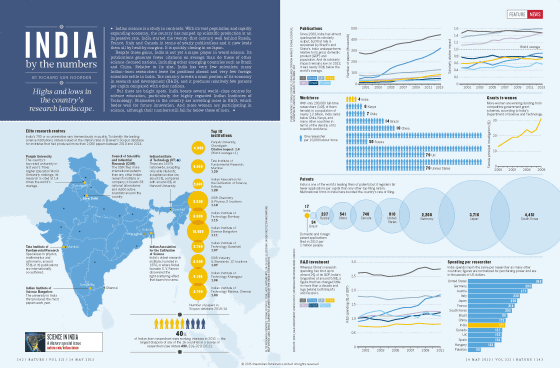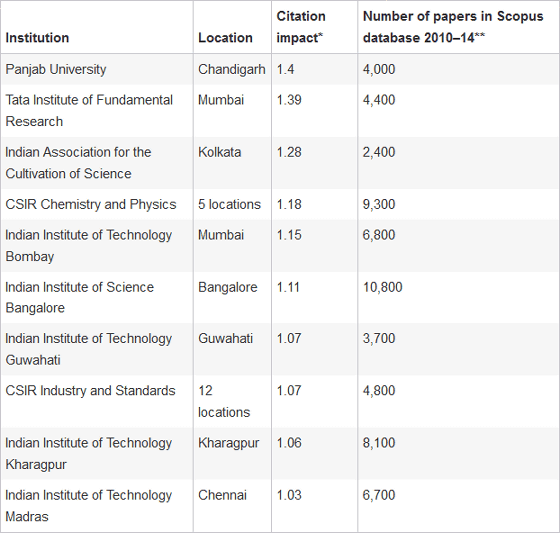"India by the numbers" summarizing the actual situation of India producing excellent scientists

From India with the world's second largest population of about 1.3 billion people, it is known that many scientists active in the world are produced. Although NASA now shows a lot of Indian scientists working, such as working, the scientific journal "NatureInteresting situation will be visible from one infograph which was created.
India by the numbers: Nature News & amp; Comment
http://www.nature.com/news/india-by-the-numbers-1.17519
(PDF file)India by the numbers

Currently, there are about 700 universities and research institutes in India. Nature is one of the world's largest abstracts and cited references database provided by ElsevierScopusBased on the list of many research institutes quoted from 2010 to 2014, we clarified where the best university and research institution in India is.
Among them, the highest number of citations, 1.4 times the global average, was in the city of Chandigarh in northern IndiaUniversity of Punjabwas. Following thisTata Basic Research Institute(Tata Institute of Fundamental Research: 1.39) andIndian Science Promotion Association(Indian Association for the Cultivation of Science: 1.28), etc. are listed. About 40% of scientists from India are getting jobs abroad and you can see that they produce excellent talent, but on the other hand it is a numerical value indicating that knowledge leakage to overseas is occurring It can be said.

Other research institution rankings are as follows.

Comparing the number of reports published since 2000, although the number of publications has increased four times between 2000 and 2013 in India, the number is quite different from the world top class That is the current situation. Orange graph shows India, but you can see how big water is being drilled in the first place in America and second place in China. Even when comparing the total number of citations, it is only 0.7 which is lower than the world average of 1.0.

There are about 200,000 scientists in India, of which approximately 14% are women. To the number per 10,000 population4 peopleIt means that it will be the number next to Kenya and Chile. In the top United States and the UK79 peopleAnd you can see that there is also a big difference here.

As mentioned above, India has a female scientist's proportion of 14%, but it is also a fact that it increases its presence every time he / she follows the year. The proportion of research that women are focused on is more than 30% of the total.

When dividing the number of patents acquired by the population and comparing the figures per million people, it looks like this. The number one in Korea · 2nd in the first place is around 4000, while in India there are 17 cases.

The ratio of R & D expenditure to GDP (gross domestic product) is about 0.9%. This also shows that the difference is expanded widely compared with about 2.7% in the United States and about 1.9% in China.

On the other hand, you can see that research expenses per researcher are aligned with the world. There is a difference compared with US $ 342,000 dollar (about 41 million yen) running through the top, India is 171 thousand dollars (about 21 million yen), which is the same level as China, the United Kingdom, etc.

Related Posts:







